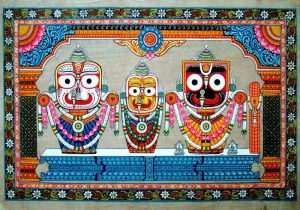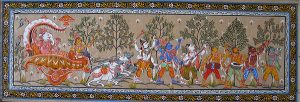As they say, painting is not just an art, but an expression. It is a way you connect with others and express your thoughts either on canvas, wall or any other medium.
Pattachitra art of odisha
The rich use of color, the visualization of the thoughts and the beauty of the Pattachitra form of art is what separates it from others. As the name suggests, it is a form of art mostly practiced bt painting on clothing.
The main standouts of these painting that makes it look unique are the portrayal of simple themes mostly revolving around Hindu mythological stories and their characters. Popular among these are the prime deity of Odisha, Jagannath, Balbhadra, and Subhadra.
Learn More: know about the paintings

The History of Pattachitra Art
The artists who make these paintings are referred to as chitrakaras, one who draws and paints. These paintings show the emotions and the story that instantly connects it to the viewers. The origin of this form of art can be dated back to 5th century BC.
These paintings are mostly found in Odisha near the Puri region from where the style of painting mostly resembles.
One can’t say that these paintings are close to real as they are purely based on the chitrakars imagination and creativity which calls for a keen observation and appreciation from the audience. These paintings are not exclusive to clothing and spread to walls as graffiti in villages.

The Techniques of Pattachitra Art
Though the world of painting has advanced a lot, the use of traditional methods by the chitrakars to paint this pattachitra is something commendable.
They still use organic materials for coloring those paintings like conch-shell for white, indigo for blue.
The Significance of Pattachitra Art
The pattas or canvas are made from the clothing glued by tamarind with chalks. The chitrakars do not use pencils or charcoal to paint the borders as they simply apply the brush to draw the paintings.
The colors are then added to the painting and a lacquer coating is added to protect it from the weather. It is a perfect blend of folk culture and the classical methods of art.

This art has passed through tough times and is still relevant today. It’s beauty, the traditional methods and the way it holds its place in the heart of people is the reason why this art is still in its full glory and holds a special place in the heart of people and it will live on for the years to come by.


